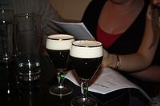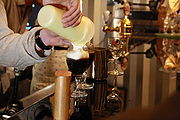
Irish coffee
Encyclopedia
Irish coffee is a cocktail
consisting of hot coffee
, Irish whiskey
, and sugar
, stirred, and topped with thick cream
. The coffee is drunk through the cream. The original recipe explicitly uses cream that has not been whipped, although whipped cream is often used. Irish coffee may be considered a variation on the hot toddy
.
at Foynes
, County Limerick
but originally from Castlederg
, County Tyrone
. Foynes' port was the precursor to Shannon International Airport in the west of Ireland
; the coffee was conceived after a group of American passengers disembarked from a Pan Am
flying boat
on a miserable winter evening in the 1940s. Sheridan added whiskey to the coffee to warm the passengers. After the passengers asked if they were being served Brazilian coffee, Sheridan told them it was Irish coffee.
Stanton Delaplane
, a travel writer for the San Francisco Chronicle
, brought Irish coffee to the United States after drinking it at Shannon Airport
, when he worked with the Buena Vista Cafe in San Francisco to start serving it on November 10, 1952, and worked with the bar owners Jack Koeppler and George Freeberg to recreate the Irish method for floating the cream on top of the coffee, sampling the drink one night until he nearly passed out. The group also sought help from the city's then mayor, George Christopher, who owned a dairy and suggested that cream aged at least 48 hours would be more apt to float. Delaplane popularized the drink by mentioning it frequently in his travel column, which was widely read throughout America. In later years, after the Buena Vista had served, by its count, more than 30 million of the drinks, Delaplane and the owners grew tired of the drink. A friend commented that the problem with Irish coffee is that it ruins three good drinks: coffee, cream, and whiskey.
Tom Bergin's Tavern
in Los Angeles
, also claims to have been the originator and has had a large sign in place reading "House of Irish Coffee" since the early 1950s.
In Spain
a "Café Irlandés" ("Irish Coffee") is sometimes served with a bottom layer of whiskey, a separate coffee layer, and a layer of cream on top. Special devices are sold for making Café Irlandés.
Other sources claim that Joe Jackson perfected the recipe at Jacksons Hotel, Ballybofey
, Co. Donegal.
 Black coffee is poured into the mug. Whiskey and at least one level teaspoon of sugar is stirred in until fully dissolved. The sugar is essential for floating liquid cream on top. Thick cream is carefully poured over the back of a spoon initially held just above the surface of the coffee and gradually raised a little. The layer of cream will float on the coffee without mixing. The coffee is drunk through the layer of cream.
Black coffee is poured into the mug. Whiskey and at least one level teaspoon of sugar is stirred in until fully dissolved. The sugar is essential for floating liquid cream on top. Thick cream is carefully poured over the back of a spoon initially held just above the surface of the coffee and gradually raised a little. The layer of cream will float on the coffee without mixing. The coffee is drunk through the layer of cream.
To ensure the integrity of the ingredients of Irish Coffee, NSAI
, Ireland's national standards body, published an Irish Standard, I.S. 417 Irish Coffee, in 1988.
Cocktail
A cocktail is an alcoholic mixed drink that contains two or more ingredients—at least one of the ingredients must be a spirit.Cocktails were originally a mixture of spirits, sugar, water, and bitters. The word has come to mean almost any mixed drink that contains alcohol...
consisting of hot coffee
Coffee
Coffee is a brewed beverage with a dark,init brooo acidic flavor prepared from the roasted seeds of the coffee plant, colloquially called coffee beans. The beans are found in coffee cherries, which grow on trees cultivated in over 70 countries, primarily in equatorial Latin America, Southeast Asia,...
, Irish whiskey
Irish whiskey
Irish whiskey is whiskey made in Ireland.Key regulations defining Irish whiskey and its production are established by the Irish Whiskey Act of 1980, and are relatively simple...
, and sugar
Sugar
Sugar is a class of edible crystalline carbohydrates, mainly sucrose, lactose, and fructose, characterized by a sweet flavor.Sucrose in its refined form primarily comes from sugar cane and sugar beet...
, stirred, and topped with thick cream
Cream
Cream is a dairy product that is composed of the higher-butterfat layer skimmed from the top of milk before homogenization. In un-homogenized milk, over time, the lighter fat rises to the top. In the industrial production of cream this process is accelerated by using centrifuges called "separators"...
. The coffee is drunk through the cream. The original recipe explicitly uses cream that has not been whipped, although whipped cream is often used. Irish coffee may be considered a variation on the hot toddy
Hot toddy
A hot toddy is a mixed drink, usually including alcohol, that is served hot. Hot toddies are traditionally drunk before going to bed, or in wet or cold weather...
.
Origin
The origin of the Irish coffee is highly disputed. According to certain sources the original Irish coffee was invented by Joseph Sheridan, a head chefChef
A chef is a person who cooks professionally for other people. Although over time the term has come to describe any person who cooks for a living, traditionally it refers to a highly skilled professional who is proficient in all aspects of food preparation.-Etymology:The word "chef" is borrowed ...
at Foynes
Foynes
Foynes is a village and major port in County Limerick in the midwest of Ireland, located at the edge of hilly land on the southern bank of the Shannon Estuary. The population of the town was 606 as of the 2006 census.-Foynes's role in aviation:...
, County Limerick
County Limerick
It is thought that humans had established themselves in the Lough Gur area of the county as early as 3000 BC, while megalithic remains found at Duntryleague date back further to 3500 BC...
but originally from Castlederg
Castlederg
Castlederg is a village in County Tyrone, Northern Ireland. It lies on the River Derg and is close to the border with County Donegal. The village has a ruined castle and two ancient tombs known as the Druid's Altar and Todd's Den...
, County Tyrone
County Tyrone
Historically Tyrone stretched as far north as Lough Foyle, and comprised part of modern day County Londonderry east of the River Foyle. The majority of County Londonderry was carved out of Tyrone between 1610-1620 when that land went to the Guilds of London to set up profit making schemes based on...
. Foynes' port was the precursor to Shannon International Airport in the west of Ireland
Ireland
Ireland is an island to the northwest of continental Europe. It is the third-largest island in Europe and the twentieth-largest island on Earth...
; the coffee was conceived after a group of American passengers disembarked from a Pan Am
Pan American World Airways
Pan American World Airways, commonly known as Pan Am, was the principal and largest international air carrier in the United States from 1927 until its collapse on December 4, 1991...
flying boat
Flying boat
A flying boat is a fixed-winged seaplane with a hull, allowing it to land on water. It differs from a float plane as it uses a purpose-designed fuselage which can float, granting the aircraft buoyancy. Flying boats may be stabilized by under-wing floats or by wing-like projections from the fuselage...
on a miserable winter evening in the 1940s. Sheridan added whiskey to the coffee to warm the passengers. After the passengers asked if they were being served Brazilian coffee, Sheridan told them it was Irish coffee.
Stanton Delaplane
Stanton Delaplane
Stanton Hill Delaplane was a travel writer, credited with introducing Irish coffee to the United States...
, a travel writer for the San Francisco Chronicle
San Francisco Chronicle
thumb|right|upright|The Chronicle Building following the [[1906 San Francisco earthquake|1906 earthquake]] and fireThe San Francisco Chronicle is a newspaper serving primarily the San Francisco Bay Area of the U.S. state of California, but distributed throughout Northern and Central California,...
, brought Irish coffee to the United States after drinking it at Shannon Airport
Shannon Airport
Shannon Airport, is one of the Republic of Ireland's three primary airports along with Dublin and Cork. In 2010 around 1,750,000 passengers passed through the airport, making it the third busiest airport in the Republic of Ireland after Dublin and Cork, and the fifth busiest airport on the island...
, when he worked with the Buena Vista Cafe in San Francisco to start serving it on November 10, 1952, and worked with the bar owners Jack Koeppler and George Freeberg to recreate the Irish method for floating the cream on top of the coffee, sampling the drink one night until he nearly passed out. The group also sought help from the city's then mayor, George Christopher, who owned a dairy and suggested that cream aged at least 48 hours would be more apt to float. Delaplane popularized the drink by mentioning it frequently in his travel column, which was widely read throughout America. In later years, after the Buena Vista had served, by its count, more than 30 million of the drinks, Delaplane and the owners grew tired of the drink. A friend commented that the problem with Irish coffee is that it ruins three good drinks: coffee, cream, and whiskey.
Tom Bergin's Tavern
Tom Bergin's
Tom Bergin's Tavern is one of the oldest restaurant/bars in continuous operation in Los Angeles, California. Originally opened on Wilshire Boulevard in 1936 by lawyer Tom Bergin, it has been at its current location on Fairfax Avenue since 1949....
in Los Angeles
Los Ángeles
Los Ángeles is the capital of the province of Biobío, in the commune of the same name, in Region VIII , in the center-south of Chile. It is located between the Laja and Biobío rivers. The population is 123,445 inhabitants...
, also claims to have been the originator and has had a large sign in place reading "House of Irish Coffee" since the early 1950s.
In Spain
Spain
Spain , officially the Kingdom of Spain languages]] under the European Charter for Regional or Minority Languages. In each of these, Spain's official name is as follows:;;;;;;), is a country and member state of the European Union located in southwestern Europe on the Iberian Peninsula...
a "Café Irlandés" ("Irish Coffee") is sometimes served with a bottom layer of whiskey, a separate coffee layer, and a layer of cream on top. Special devices are sold for making Café Irlandés.
Other sources claim that Joe Jackson perfected the recipe at Jacksons Hotel, Ballybofey
Ballybofey
Ballybofey is a town located on the south bank of the River Finn, County Donegal, Ireland. Along with the smaller town of Stranorlar on the north side of the River Finn, Ballybofey makes up the Twin Towns....
, Co. Donegal.
Preparation

To ensure the integrity of the ingredients of Irish Coffee, NSAI
National Standards Authority of Ireland
The National Standards Authority of Ireland, or NSAI, is the International Organization for Standardization member body for the Republic of Ireland...
, Ireland's national standards body, published an Irish Standard, I.S. 417 Irish Coffee, in 1988.
External links
- The Irish Coffee Story by The Buena Vista Cafe, San Francisco, CA

